
|

|
|
Home Site Search Contact Us Subscribe
|
|
|
Copenhagen Design Week 2009: The focus was firmly on the local and national design community - and environmental sustainability Diverse offerings demonstrated that while classic, mid-century modern Danish design is inspiring, it's in the past; a new generation is looking towards sustainable and human-centered designs By Terri Peters September 24, 2009 Copenhagen hosted the first ever Danish Design Week, August 26 to September 6, which included more than 30 exhibitions, events, and seminars celebrating Danish product design, furniture, architecture, and fashion. Fittingly, the event focused on a main theme of environmental sustainability, as the city is already making preparations for the COP15 Climate Change Conference it will host in December.
From bamboo bicycles to solar collecting curtains to intelligent building façades, the week sought to position Denmark’s design image as one of the more progressive and ecologically minded in Europe. And it succeeded. Visitors saw a more experimental side of Danish design. Radical fashion design from Denmark and Berlin at Bright Green Fashion contrasted with more conceptual projects at It’s a Small World that ranged from city plans to carbon fiber seating. The diverse examples helped demonstrate that while classic, mid-century modern Danish design is inspiring, it’s in the past. A new generation is looking towards sustainable and human-centered designs that involve digital crafting and fabrication using new materials and technologies.
Many of the events during Design Week emphasized knowledge-building and community participation (through seminars such as Designing for Good chaired by design critic Alice Rawsthorne), rather than consumerism; there were few shopping events, which was refreshing – although perhaps a few opportunities to buy what was being exhibited other than in gallery gift shops would have been welcomed.
In contrast to this week’s London Design Festival, which presents a variety of talent beyond the British design scene, the focus in Copenhagen was firmly on the local and national design community – though most of the shows and information were in English and there were some high profile non-Danish participants.
There were numerous business seminars to engage the community beyond the design industry. For example, the Co-Creation seminar was an interesting sounding two-day seminar by invitation only for Danish businesspeople, designers, and practitioners. The sold-out Cradle-to-Cradle: Business Strategy for the 21st Century seminar was a big draw across several sectors including architects, clients, fabricators, and educators. Cradle-to-Cradle is a design philosophy introduced in the book Cradle-to-Cradle: Remaking the Way We Make Things, by architect William McDonough and material scientist Dr. Michael Braungart in 2002.
McDonough and Braungart’s consultancy McDonough Braungart Design Chemistry (MBDC) analyzes materials and processes for clients, such as Boeing and Nike, who want their products to be Cradle-to-Cradle certified. Of course, being seen as “sustainable” is good business, but seminars like this one seek to determine if being sustainable can actually be good for business beyond public relations. As a movement in design (and therefore business), it is gaining momentum. A key to this way of thinking is to realize that things cannot be just “thrown away,” because everything goes somewhere when its lifespan is exhausted. Thinking about how an object will end up during the actual design phase should be commonplace, but in reality, it is not. During the course of the day, various speakers, including Braungart, cited examples of Cradle-to-Cradle as being good design, refuting stereotypes that “good design” and “sustainability” are not always the same thing. The Think chair by office furniture company Steelcase is a good example: it can be easily assembled, easily repaired, and, when it is no longer needed, the parts can be disassembled and reused or recycled. And it is profitable – the chair one of the company’s best selling products.
Another key event during the week was “Showhow,” an exhibition of environmental design in Danish architecture, transportation, and energy. From lovely bamboo chairs from we.do.wood to designer bamboo cycles from Biomega, the show also featured some local student works alongside design heavyweights such as Greg Lynn. Pieces of the exhibition architecture – custom recycled cardboard boxes – were given away on the last day as designer souvenirs.
“It’s a Small World” at the Danish Design Centre was focused on four themes: sustainability, human scale, new craftsmanship, and non-standard praxis. Several sub-themes explored work at various scales by Danish designers. Local architects Bjarke Ingles Group (BIG) exhibited in a section called "I’m So Special," with white concept models as well as personal screens and headphones to hear the architect talk about the design process. But by putting on headphones to have the meaning of the work spoon-fed to us, we are blocking out the world. Is this really making the viewer more connected? Nearby, artists Henrik Vibskov and Andreas Emenius exhibited their spinning orange “Soul Wash,” which allowed visitors to walk between the tasseled columns as they swished around. This particular piece wasn’t terribly enlightening in terms of sustainability, but it was, like everything at the show, graphic and visually engaging. The exhibition design was by researchers at the Centre for Information Technology and Architecture (CITA) at the Royal Academy of Fine Arts School of Architecture. The modular design components that functioned as podiums, walls, and floors effectively showcased the performance of a standard building material: aluminum and plastic cassette panels. These were scored and folded to be a lightweight and materially optimized way of creating mass customized exhibition environments throughout the show.
Architects at 3XN held a series of workshops at their canal-front offices. Perhaps next year this could be expanded to allow more visitors a look inside the city’s design offices. It would be even better to include tours of more of the city’s recent architecture, beyond landmarks like the Opera House and the Playhouse – maybe views into sustainable renovations or tours of areas of new development in the city?
Terri Peters is an architect and researcher based in Copenhagen.
Also by this author:
Exhibition Review: "Yes is More": BIG at DAC, Copenhagen Though
the firm's housing projects are amazing and their enthusiasm is great, the
comic book graphics are a bit much - it's hard not to roll your eyes, but
definitely worth the roll. Field Notes from the 11th Venice Architecture Biennale - Part 2 The
Giardini: "Experimental Architectures" offers a glimpse of 30
countries' current architectural debates and experiments. Field Notes from the 11th Venice Architecture Biennale - Part 1 The
Arsenale: Betsky's eclectic curating and the polished and thoughtful
presentations of the exhibitors make it a challenging, entertaining, and
provocative show. Architecture Supermodels: Report from SmartGeometry Conference Parametric design is set to revolutionize the way buildings are designed and built.
|
(click on pictures to enlarge) 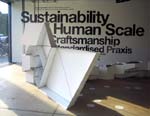 Terri Peters “It’s A Small World”: the exhibition presented Danish architecture, design, and craft in the context of sustainability and globalization. 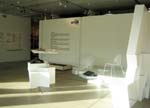 Terri Peters “It’s A Small World”: The exhibition design featured a hexagonal grid of scored and folded aluminum and plastic cassettes that created customized environments throughout the show. 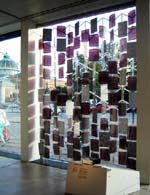 Terri Peters “It’s A Small World”: Textile designer Astrid Krogh showed Suntiles, a study for an alternative curtain that is able to store and release energy. 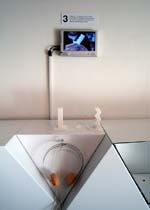 Terri Peters “It’s A Small World”: a detail of Bjarke Ingles Group (BIG) display 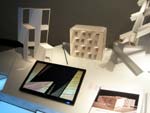 Terri Peters “It’s A Small World”: Local architects 3XN showed its headquarters project for the Danish law firm Horten in Copenhagen. 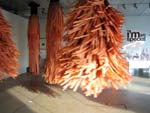 Terri Peters “It’s A Small World”: the spinning “Soul Wash” by artists Henrik Vibskov and Andreas Emenius 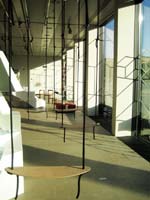 Terri Peters “It’s A Small World”: Visitors could swing on timber handcrafted swings.  Copenhagen Design Week Swinging around at “It’s A Small World” 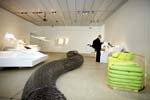 Copenhagen Design Week In the center of one of the rooms at the Danish Design Centre, visitors find a sinuous carbon-fiber seat by Mathias Bengtsson. 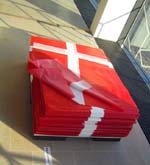 Terri Peters “It’s A Small World”: A pile of Danish flags, one per person please.  Steelcase Steelcase’s best seller, the Think chair, iscertified Cradle-to-Cradle Gold. 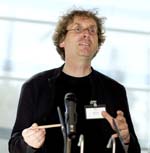 Copenhagen Design Week The material scientist and “Cradle-to-Cradle” co-author Michael Braungart gave a humorous and inspiring lecture about his philosophy of design.  Biomega Bamboo-framed bike by the Danish cycle company Biomega 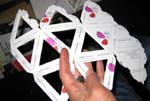 Terri Peters Collective Paper Aesthetics by architect Noa Haim 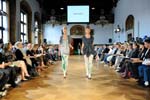 Jan Rasmus Voss At Bright Green Fashion, Julia Knupfer showed a selection of sustainable designs. |
© 2009 ArchNewsNow.com